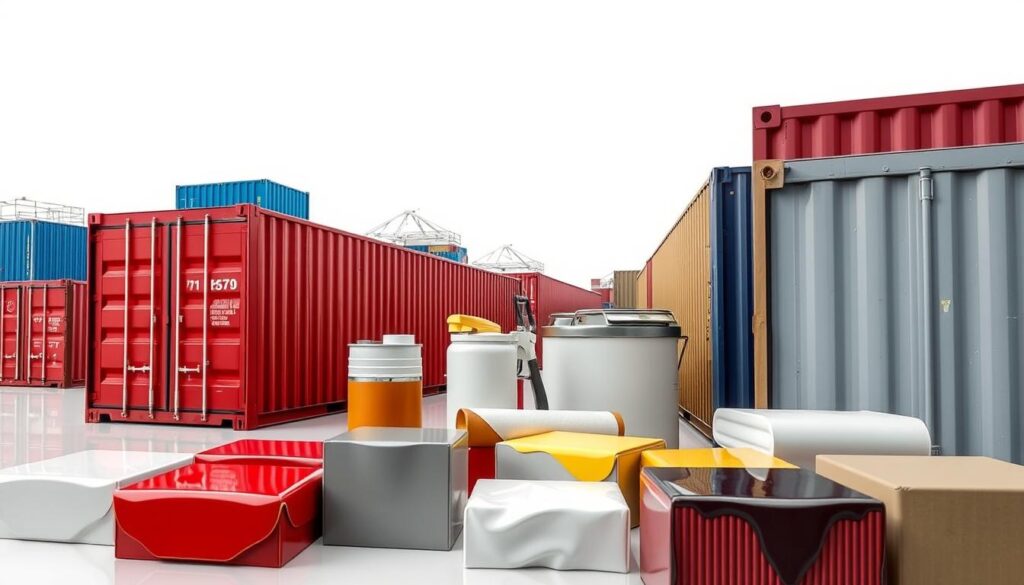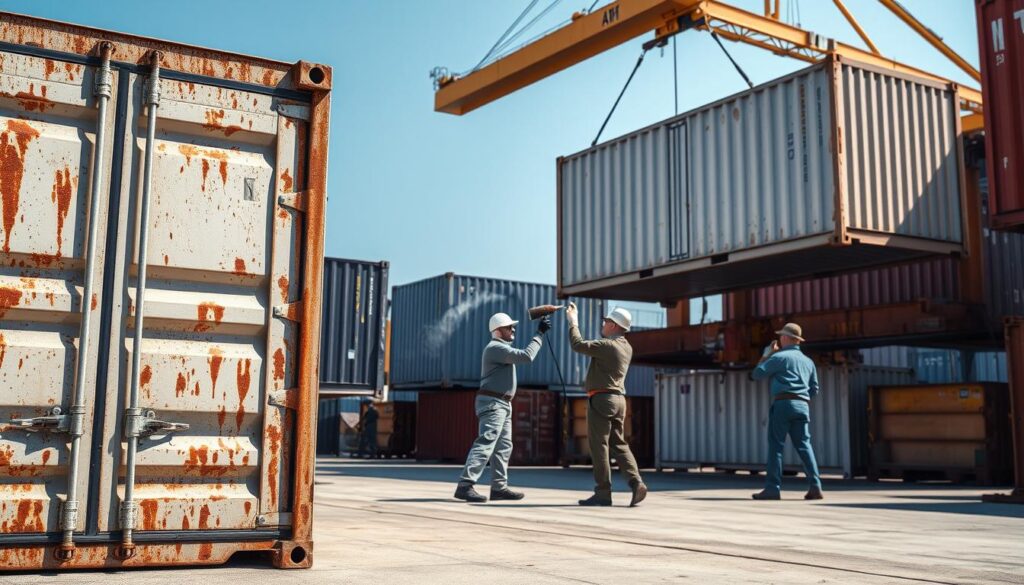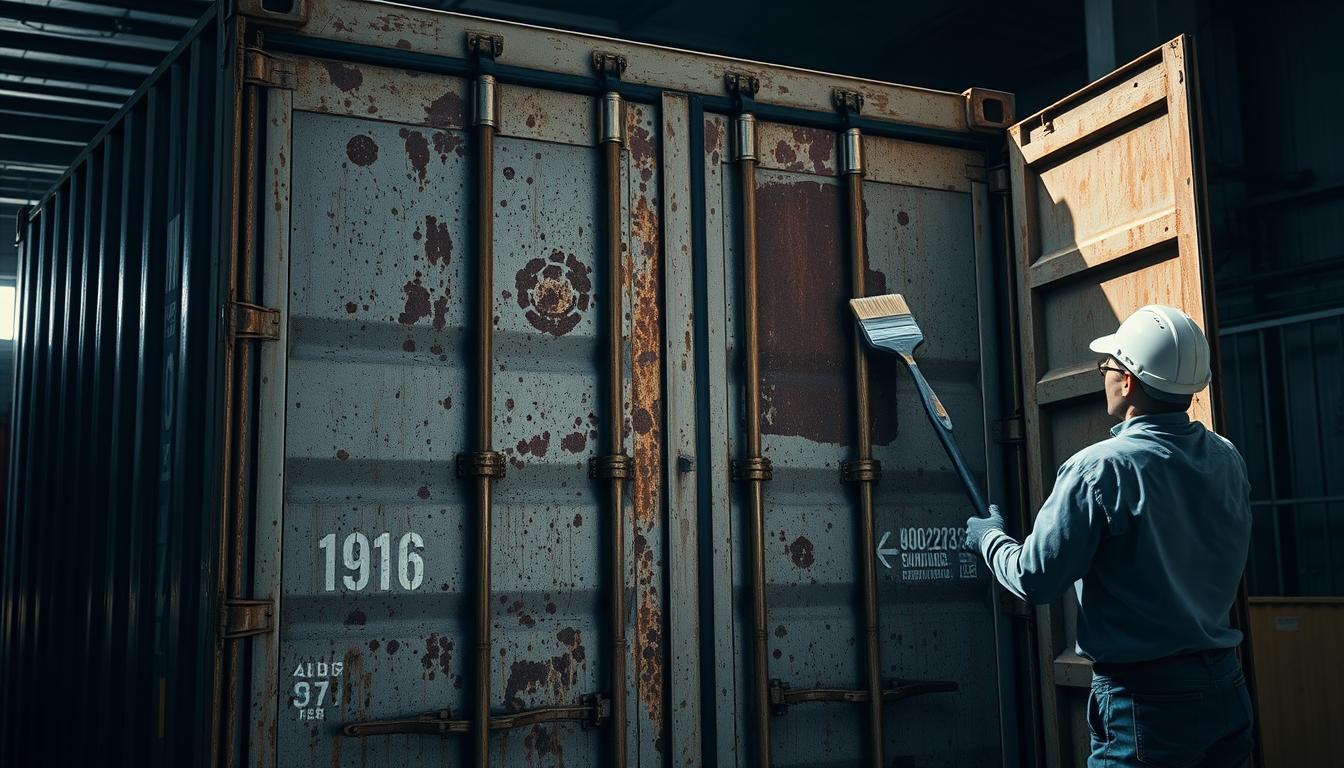Are your shipping containers exposed to the elements, silently corroding away? Rust can be a costly and debilitating issue for container owners.
Corrosion can compromise the integrity of your containers, leading to safety hazards and financial losses. So, what can you do to protect your shipping containers from the ravages of rust?
The good news is that there are effective methods to prevent corrosion and extend the lifespan of your containers. In this article, we’ll explore the best ways to safeguard your shipping containers against rust.
Key Takeaways
- Understand the causes of shipping container rust
- Learn effective methods for preventing corrosion
- Discover the importance of regular maintenance
- Explore coating and lining options for rust protection
- Find out how to inspect your containers for damage
Understanding Rust and Its Impact on Shipping Containers
Understanding the causes and effects of rust on shipping containers is crucial for maintaining their condition. Rust can compromise the structural integrity of these containers, leading to safety hazards and financial losses.
What Causes Rust on Shipping Containers
Rust on shipping containers is primarily caused by exposure to moisture and oxygen. When metal surfaces come into contact with water or high humidity, the oxidation process accelerates, leading to the formation of rust. Coastal areas with high salt content in the air can further exacerbate this issue.
Other factors contributing to rust include damage to the container’s paint or coating, exposure to chemicals, and poor maintenance practices.
The Destructive Effects of Corrosion
The effects of corrosion on shipping containers can be severe. As rust progresses, it weakens the metal, potentially leading to holes, structural failures, and safety risks. Corrosion can also compromise the container’s watertight seal, allowing further moisture ingress and accelerating the deterioration process.
Common Vulnerable Areas on Shipping Containers
Certain areas on shipping containers are more prone to rust due to their design or function. These include:
- The base of the container, where water tends to accumulate.
- Door hinges and locking mechanisms, which are prone to moisture retention.
- Any areas with damaged or worn-out coatings.
Regular inspection and maintenance of these vulnerable areas are critical to preventing rust and ensuring the longevity of shipping containers.
How to Keep a Shipping Container from Rusting: Essential Preventive Measures
Effective rust prevention strategies are vital for protecting your shipping container from corrosion and damage. By taking proactive steps, you can significantly extend the lifespan of your container and maintain its structural integrity.
Initial Assessment of Container Condition
Before implementing any rust prevention measures, it’s crucial to assess the current condition of your shipping container. Inspect the container thoroughly for any signs of rust or corrosion, paying particular attention to areas prone to moisture accumulation, such as corners and welds. This initial assessment will help you identify potential vulnerabilities and develop a targeted prevention plan.
Creating a Rust Prevention Plan
Once you’ve assessed your container’s condition, the next step is to create a comprehensive rust prevention plan. This plan should include regular inspection schedules, cleaning protocols, and the application of protective coatings or treatments. Consider factors such as the container’s location, climate, and intended use when developing your plan. For instance, containers stored in coastal areas may require more frequent inspections and treatments due to the higher salt content in the air. You can explore more about adapting protection methods for different environments by visiting our article on whether shipping containers are good for underground.
Tools and Materials Needed for Rust Prevention
To effectively prevent rust, you’ll need the right tools and materials. Essential items include a wire brush for removing rust, a rust converter or inhibitor, and a high-quality protective coating or paint specifically designed for rust prevention for storage containers. Additionally, consider using anti-rust methods for shipping containers such as applying a rust-inhibiting primer before painting. Having the correct materials on hand will enable you to address any rust issues promptly and effectively.
By following these essential preventive measures, you can protect your shipping container from rust and ensure it remains in good condition for years to come. Regular maintenance and the right protective treatments are key to maintaining the integrity and longevity of your container.
Regular Maintenance Practices for Rust Prevention
Rust prevention on shipping containers requires a proactive approach, starting with regular maintenance. By adopting a consistent maintenance routine, you can significantly extend the lifespan of your shipping container and protect your investment.
Scheduled Inspection Routines
Regular inspections are crucial for identifying potential rust issues before they become major problems. It’s recommended to inspect your shipping container at least twice a year, or more frequently if it’s exposed to harsh environmental conditions.
During these inspections, pay close attention to areas prone to rust, such as the container’s corners, edges, and any areas with damaged paint or coating. Look for signs of rust, including discoloration, flaking, or bubbling of the metal surface.
Cleaning Protocols to Prevent Corrosion
Cleaning is an essential part of maintaining a rust-free shipping container. Dirt, grime, and salt can all contribute to corrosion, so it’s vital to keep your container clean, especially after exposure to harsh weather conditions or sea salt.
Use a mild detergent and water to clean the container, avoiding harsh chemicals that could damage the coating or paint. Ensure the container is thoroughly rinsed and dried to prevent water spots.
Addressing Minor Rust Issues Before They Spread
When minor rust issues are identified, it’s crucial to address them promptly to prevent them from spreading. Start by cleaning the affected area thoroughly, then use a rust converter or remover to treat the rust.
After treating the rust, apply a rust-inhibiting primer and paint to protect the metal from further corrosion. Regularly monitoring and addressing minor rust issues will help maintain your shipping container in a rust-free condition.
| Maintenance Task | Frequency | Benefits |
|---|---|---|
| Inspect for Rust | Every 6 months | Early detection of rust issues |
| Clean Container | After harsh weather or as needed | Prevents dirt and grime buildup |
| Treat Minor Rust | As needed | Prevents rust from spreading |
Protective Coatings and Paints for Shipping Containers
Rust prevention is a top priority for shipping container owners, and using the right protective coatings and paints is a key strategy. The right coatings not only enhance the durability of the containers but also protect them against the harsh conditions they are often exposed to.
Marine-Grade Paints and Their Benefits
Marine-grade paints are specifically designed to withstand harsh marine environments, making them ideal for shipping containers. These paints offer superior resistance to corrosion and can endure the rigors of sea travel and storage in coastal areas. Some of the key benefits include:
- High durability and resistance to chipping and fading
- Excellent adhesion to metal surfaces
- Resistance to saltwater and humidity
Rust-Inhibiting Primers and Sealants
Before applying paint, using a rust-inhibiting primer can significantly enhance the protective capabilities of the coating. These primers are formulated to actively prevent rust formation on metal surfaces. Additionally, sealants can be applied as a topcoat to provide an extra layer of protection against moisture.
Application Techniques for Maximum Protection
The effectiveness of protective coatings and paints largely depends on their application. Proper surface preparation and application methods are crucial.
Surface Preparation Steps
To ensure a long-lasting finish, the surface must be properly prepared. This involves:
- Cleaning the surface to remove dirt and grease
- Sanding to create a rough surface for better paint adhesion
- Removing any existing rust or old paint
Proper Application Methods
Once the surface is prepared, the coating or paint should be applied according to the manufacturer’s instructions. This typically involves applying a primer first, followed by one or more coats of paint or coating. It’s essential to allow adequate drying time between coats.

By following these guidelines and using the right materials, shipping container owners can significantly extend the life of their containers. Regular maintenance and inspections will further ensure that the containers remain in good condition.
Professional Rust Treatment Options for Storage Containers
When it comes to maintaining the integrity of shipping containers, professional rust treatment options are essential for preventing rust on shipping containers. Rust can significantly compromise the structural integrity of these containers, leading to costly repairs or even replacement.
Professional rust treatment involves a comprehensive approach that includes thorough inspection, surface preparation, and application of protective coatings. According to industry experts, “regular maintenance and rust prevention measures can extend the lifespan of shipping containers by several years” (
).
Sandblasting and Surface Preparation Services
Sandblasting is a critical step in the rust treatment process, as it removes dirt, grime, and existing rust from the container’s surface. This process helps create a clean surface for the application of protective coatings, ensuring a strong bond between the metal and the coating.
Professional Coating Applications
After surface preparation, professional coating applications provide a robust barrier against corrosion. Various coating options are available, including epoxy, polyurethane, and rust-inhibiting primers. The choice of coating depends on the container’s intended use, environmental conditions, and desired level of protection.
Cost-Benefit Analysis of Professional Treatments
While professional rust treatment may seem like a significant upfront investment, it can lead to substantial long-term savings. By preventing rust on shipping containers, owners can avoid costly repairs, reduce downtime, and extend the container’s lifespan. A cost-benefit analysis can help container owners understand the value of professional rust treatment and make informed decisions about their maintenance budget.
By investing in professional rust treatment options, shipping container owners can ensure their containers remain in good condition, reducing the risk of rust-related damage and associated costs. Effective rust prevention for storage containers is crucial for maintaining their integrity and extending their lifespan.
DIY Rust Removal and Prevention Methods
Rust on shipping containers doesn’t have to be a permanent problem, thanks to effective DIY solutions. With the right techniques and materials, you can protect your container from the damaging effects of rust.
Effective Household Solutions for Minor Rust
For minor rust issues, several household items can be repurposed as effective rust removal agents. Vinegar and baking soda are two such items that can be used to remove rust. The acid in vinegar helps break down rust, while baking soda acts as a mild abrasive to remove the rust residue.
To use this method, mix baking soda with water to form a paste, apply it to the rusted area, and let it sit for a few hours. Then, scrub the area with a brush and rinse with water. For more stubborn rust, soaking the area in vinegar before applying the baking soda paste can enhance the effectiveness.

Step-by-Step Rust Removal Process
Removing rust from shipping containers involves a systematic approach to ensure thorough removal and prevention of future rust. Here’s a step-by-step guide:
- Clean the area around the rust to remove any debris.
- Apply a rust remover or a household solution like vinegar and baking soda.
- Let the solution sit for the recommended time before scrubbing.
- Rinse the area thoroughly and dry it.
- Inspect the area for any remaining rust and repeat the process if necessary.
Applying DIY Protective Treatments
After removing rust, applying a protective treatment is crucial to prevent future rust formation. DIY protective treatments can be just as effective as commercial products. One method is to apply a coat of rust-inhibiting primer followed by a durable topcoat.
| Material | Purpose | Application Method |
|---|---|---|
| Rust-inhibiting primer | Prevents rust formation | Brush or spray application |
| Durable topcoat | Protects against environmental elements | Brush or spray application |
By following these DIY rust removal and prevention methods, you can significantly extend the lifespan of your shipping container and protect your investment. Regular maintenance and the right protective treatments are key to keeping rust at bay.
Environmental Considerations for Rust Protection
Different environments pose unique challenges to maintaining a rust-free shipping container. The effectiveness of rust protection measures largely depends on understanding and adapting to these environmental conditions.
Adapting Protection Methods for Coastal Areas
Coastal areas expose shipping containers to high levels of salt and moisture, significantly increasing the risk of corrosion. To combat this, using marine-grade coatings and regular washing to remove salt deposits can be highly effective.
Rust Prevention in High-Humidity Environments
In high-humidity environments, moisture is the primary culprit behind rust formation. Ensuring good ventilation and using rust-inhibiting primers can help mitigate this issue.
Winter Protection Strategies for Shipping Containers
During winter, the use of de-icing salts and exposure to freezing temperatures can accelerate rust formation. Applying a protective wax coating and ensuring proper drainage can help protect containers from these harsh conditions.
By understanding the specific challenges posed by different environments and implementing tailored corrosion protection for storage containers, it’s possible to significantly extend the lifespan of shipping containers.
Long-Term Strategies to Maintain a Rust-Free Container
Effective long-term rust prevention for shipping containers involves understanding the root causes of corrosion and addressing them proactively. By adopting a comprehensive approach, you can significantly extend the lifespan of your container and protect your investment.
Structural Modifications to Prevent Water Accumulation
One of the primary causes of rust on shipping containers is water accumulation. Modifying the structure to prevent water from pooling can significantly reduce the risk of corrosion. This can involve ensuring that the container’s roof is clear of debris, installing drainage systems, or modifying the container’s design to improve water runoff.
For instance, installing a sloping roof or ensuring that the container’s doors are properly sealed can make a significant difference. Regular inspections can help identify potential issues before they become major problems.
Ventilation Solutions to Reduce Moisture
Adequate ventilation is crucial for reducing moisture inside the container, thereby minimizing the risk of rust. Installing vents or ventilation systems can help maintain a dry environment. This is particularly important in humid or coastal areas where moisture levels are higher.
Ventilation solutions can range from simple vent installations to more complex systems that actively circulate air. The key is to ensure that air can circulate freely, reducing the likelihood of moisture buildup.
Sacrificial Anodes and Other Advanced Protection Methods
For added protection, some container owners opt for advanced methods such as sacrificial anodes. These anodes are made from materials that corrode more easily than the container’s material, thereby protecting it from rust.
Other advanced protection methods include applying specialized coatings or linings that are designed to withstand harsh environments. These methods can be particularly effective in extreme conditions, such as high salinity or high humidity.
By implementing these long-term strategies, you can ensure that your shipping container remains in good condition, reducing the need for costly repairs and extending its usable life.
Conclusion: Ensuring Your Shipping Container’s Longevity
Protecting your shipping container from rust is crucial for its longevity and functionality. By understanding the causes of rust and implementing preventive measures, you can significantly extend the life of your container.
Regular maintenance practices, such as scheduled inspections and cleaning protocols, play a vital role in maintaining a rust-free shipping container. Applying protective coatings and paints, like marine-grade paints and rust-inhibiting primers, can also provide a robust defense against corrosion.
To keep your shipping container in optimal condition, it’s essential to address minor rust issues promptly and consider professional rust treatment options when needed. By following these strategies and adapting them to your container’s specific environment, you can ensure its longevity and maintain its structural integrity.
By implementing these methods, you can effectively learn how to keep a shipping container from rusting and maintain a rust-free shipping container, safeguarding your investment for years to come.

